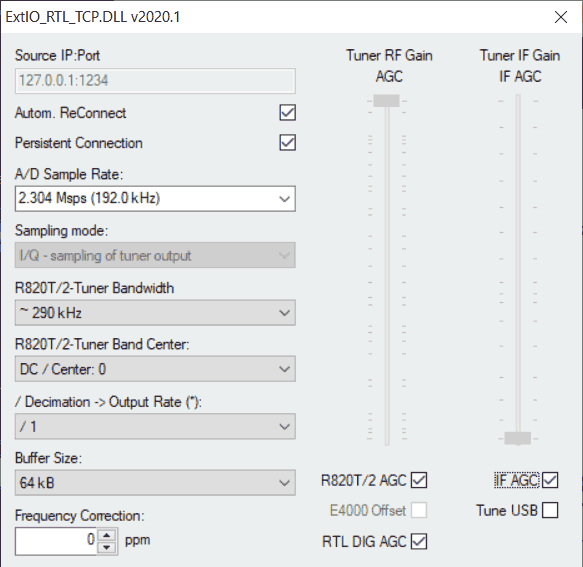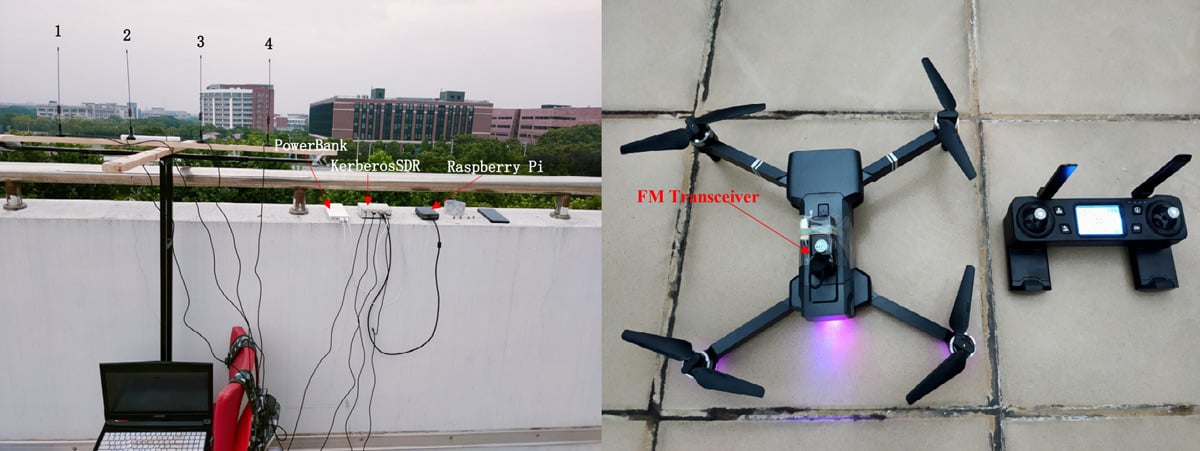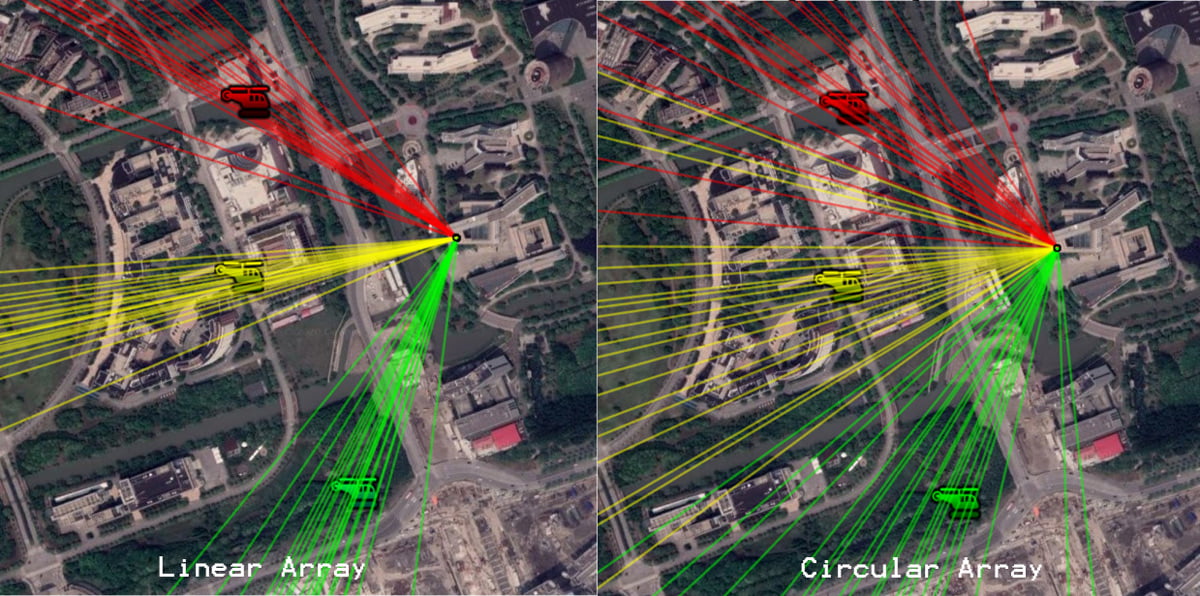"Driver" Library Features
- added support for special USB (vendor) VID 0x1209 (product) PID 0x2832: "Generic RTL2832U":
- A special USB vendor/product id got reserved at http://pid.codes/1209/2832/
- for such devices the linux kernel's DVB modules are not loaded automatically, thus can be used without blacklisting dvb_usb_rtl28xxu below /etc/modprobe.d/
- this allows to use a second RTL dongle for use with DVB in parallel
- the IDs can be programmed with 'rtl_eeprom -n' or 'rtl_eeprom -g realtek_sdr'
- see https://www.rtl-sdr.com/watching-dvb-t-tv-and-using-sdr-mode-at-the-same-time-with-two-rtl-sdrs/
- added support for using RTLSDR-Dongle from remote - see rtl_rpcd and README.rtlsdr_rpc
- improvements for R820T/2 tuner also see https://codingspirit.de/librtlsdr-driver.pdf
- added better bandwidth support
- added smaller bandwidths, improving selectivity: 290, 375, 420, 470, 600, 860, 950, 1100, 1300, 1500, 1600, 1750, 1950 kHz. These are coarse measured values .. which might get adjusted in future.
- bandwidth filters utilize tuner's low- and highpass filters at IF
- added spectrum flipping (inside tuner) - and back in RTL2832
- the band edges (low/high-pass) have different steepness; the steeper edge can be selected with the mixer sideband (rtlsdr_set_tuner_sideband()), to achieve better attenuation depending on signal scenario
- added (automatic) control over VGA (variable gain amplifier)
- VGA gain (besides LNA and Mixer) can be utilized and set to automatic, letting it controlled from RTL2832U. Having all automatic (AGC) including activation of digital AGC in RTL2832 (rtlsdr_set_agc_mode()), oversteering effects got reduced (a lot).
- gain range now up to 100 dB
- deactivated "Filter extension under weak signal" for a stable filter characteristic
- added shifting of IF-center, to receive away from DC. See rtlsdr_set_tuner_band_center()
- added better bandwidth support
- probably some more: it's highly probable, that this list is incomplete
"Driver" Library API
- added rtlsdr_set_and_get_tuner_bandwidth(), which also delivers the bandwidth. [ with rtlsdr_set_tuner_bandwidth() does not deliver the bandwidth ]
- added rtlsdr_set_tuner_band_center(), to set center of the filtered tuner band
- added rtlsdr_set_tuner_sideband(), to set mixer sideband
- added rtlsdr_set_tuner_gain_ext(), special for R820T/2 tuner
- added rtlsdr_set_tuner_if_mode(), sets AGC modes in detail
- added rtlsdr_set_ds_mode() including threshold frequency
- added rtlsdr_ir_query()
- added rtlsdr_set_opt_string() and rtlsdr_get_opt_help() for configuration of 'driver' - especially from command line
- added rtlsdr_set_tuner_i2c_register(), rtlsdr_get_tuner_i2c_register() and rtlsdr_set_tuner_i2c_override() exposing hacking of tuner-specific I2C registers
- added rtlsdr_get_ver_id(), to allow discrimination between osmocom library - or this fork
- added rtlsdr_get_version()
Added Tools
- added rtl_ir: display received IR signals.
- requires the IR diode of an RTL-SDR - which might not exist!
- added rtl_rpcd: a Remote Procedure Call server for RTL-SDR dongles.
- for use, set environment variable "RTLSDR_RPC_IS_ENABLED"
- optionally set environment varibales "RTLSDR_RPC_SERV_ADDR" and "RTLSDR_RPC_SERV_PORT". These default to "127.0.0.1" and "40000".
- requires cmake option WITH_RPC
- added rtl_raw2wav: save rtl_sdr or rtl_fm's output (pipe) into a wave file, including some meta information like timestamp and frequency
- added rtl_udp: same as rtl_tcp - just using UDP instead of TCP
- added rtl_wavestat: display wave file meta information
- added rtl_wavestream: stream raw data (in specified format)
Improved Tools
- rtl_fm:
- added command file option '-C', which can trigger actions depending on signal. have a look at README.rtlfm_cmdfile.
- added command line interface option '-E rdc', to enable dc blocking on raw I/Q data at capture rate
- added CLI option '-E rtlagc', to enable rtl2832's digital agc
- added CLI option '-E bclo', to use tuner bandwidths low corner as band center
- added CLI option '-E bchi', to use tuner bandwidths high corner as band center
- added CLI option '-O', to set RTL driver options seperated with ':', e.g. -O 'bc=30000:agc=0'
- added CLI option '-R', to specify number of seconds to run
- added CLI option '-H', to write wave Header to file, producing a wave file with meta information, compatible with several SDR programs
- added CLI option '-o', to request oversampling (4 recommended) for processing gain
- not just rtl_fm, but many tools have more options. compare all the details by starting with command line option '-h'.
"Driver" Library's UDP-Server - only on Windows
- enabled by cmake option PROVIDE_UDP_SERVER for tests. OFF by default
- activated by rtlsdr_set_opt_string(): "port=1" or "port=<udp_port>", default port number: 32323
- purpose is to allow configuration at runtime with a simple text protocol, e.g. with netcat
- for detailed protocol, see comment section in parse() of librtlsdr.c. or look for sections with '#ifdef WITH_UDP_SERVER'
RTL_TCP TCP-PROTOCOL
- allows non-GPL programs, e.g. QIRX, to utilize the RTLSDR stuff in a license compliant way
- added several control functions in rtl_tcp, not existing in osmocom release: UDP_ESTABLISH, UDP_TERMINATE, SET_I2C_TUNER_REGISTER, SET_I2C_TUNER_OVERRIDE, SET_TUNER_BW_IF_CENTER, SET_TUNER_IF_MODE, SET_SIDEBAND, REPORT_I2C_REGS
- control functions documented in rtl_tcp.h
- (by default) control port number 1234, configurable via command-line-interface (CLI)
- response(s) at +1 of control port: 1235, configurable via CLI
- protocol details in protocol_rtl_tcp.txt


